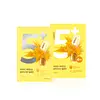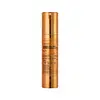What's inside
What's inside
 Key Ingredients
Key Ingredients

 Benefits
Benefits

 Concerns
Concerns

No concerns
 Ingredients Side-by-side
Ingredients Side-by-side

Water
Skin ConditioningMethylpropanediol
SolventNiacinamide
SmoothingPEG/PPG-17/6 Copolymer
SolventCoptis Japonica Root Extract
Skin Conditioning1,2-Hexanediol
Skin ConditioningHydroxyacetophenone
AntioxidantHydroxyethyl Urea
HumectantIsopentyldiol
HumectantMethyl Gluceth-20
HumectantCarbomer
Emulsion StabilisingAllantoin
Skin ConditioningSodium Ascorbyl Phosphate
AntioxidantGlutathione
Hydrogenated Lecithin
EmulsifyingPEG-60 Hydrogenated Castor Oil
EmulsifyingXanthan Gum
EmulsifyingAdenosine
Skin ConditioningEthylhexylglycerin
Skin ConditioningSodium Polyacrylate
AbsorbentButylene Glycol
HumectantCentella Asiatica Extract
CleansingDisodium EDTA
Hydroxyethylcellulose
Emulsion StabilisingMethyl Diisopropyl Propionamide
MaskingPolyglutamic Acid
Skin ConditioningProtease
ExfoliatingCeramide NP
Skin ConditioningAscorbic Acid
AntioxidantArbutin
AntioxidantBisabolol
MaskingHyaluronic Acid
HumectantWater, Methylpropanediol, Niacinamide, PEG/PPG-17/6 Copolymer, Coptis Japonica Root Extract, 1,2-Hexanediol, Hydroxyacetophenone, Hydroxyethyl Urea, Isopentyldiol, Methyl Gluceth-20, Carbomer, Allantoin, Sodium Ascorbyl Phosphate, Glutathione, Hydrogenated Lecithin, PEG-60 Hydrogenated Castor Oil, Xanthan Gum, Adenosine, Ethylhexylglycerin, Sodium Polyacrylate, Butylene Glycol, Centella Asiatica Extract, Disodium EDTA, Hydroxyethylcellulose, Methyl Diisopropyl Propionamide, Polyglutamic Acid, Protease, Ceramide NP, Ascorbic Acid, Arbutin, Bisabolol, Hyaluronic Acid
Water
Skin ConditioningDipropylene Glycol
HumectantGlycerin
HumectantNiacinamide
SmoothingPolyglycerin-3
HumectantCaprylic/Capric Triglyceride
Masking1,2-Hexanediol
Skin ConditioningSilica
AbrasiveBetaine
HumectantSodium Carbomer
Emulsion StabilisingAmmonium Acryloyldimethyltaurate/Vp Copolymer
Ethylhexylglycerin
Skin ConditioningAcrylates/C10-30 Alkyl Acrylate Crosspolymer
Emulsion StabilisingC12-14 Alketh-12
EmulsifyingHydroxyethylcellulose
Emulsion StabilisingHydroxyacetophenone
AntioxidantCaprylyl Glycol
EmollientAdenosine
Skin ConditioningButylene Glycol
HumectantTromethamine
BufferingCyamopsis Tetragonoloba Gum
Emulsion StabilisingMelia Azadirachta Leaf Extract
Skin ConditioningDisodium EDTA
Agar
MaskingUbiquinone
AntioxidantMelia Azadirachta Flower Extract
Skin ConditioningCurcuma Longa Root Extract
MaskingXanthan Gum
EmulsifyingCentella Asiatica Extract
CleansingAscorbic Acid
AntioxidantOcimum Sanctum Leaf Extract
Skin ConditioningTocopherol
AntioxidantHydrogenated Polydecene
EmollientHippophae Rhamnoides Fruit Oil
Skin ProtectingGlutathione
Hippophae Rhamnoides Water
MaskingPropanediol
SolventCorallina Officinalis Extract
Skin ConditioningPolyglyceryl-10 Laurate
Skin ConditioningAstaxanthin
Skin ConditioningHydrogenated Phosphatidylcholine
EmulsifyingRetinyl Palmitate
Skin ConditioningDisodium Phosphate
BufferingPolysorbate 60
EmulsifyingEurya Japonica Extract
Skin ConditioningSodium Phosphate
BufferingSodium Lauroyl Glutamate
Mentha Viridis Extract
MaskingSodium Hyaluronate
HumectantPropolis Extract
Skin ConditioningFerulic Acid
AntimicrobialAsiaticoside
AntioxidantAsiatic Acid
Skin ConditioningMadecassic Acid
Skin ConditioningMadecassoside
AntioxidantWater, Dipropylene Glycol, Glycerin, Niacinamide, Polyglycerin-3, Caprylic/Capric Triglyceride, 1,2-Hexanediol, Silica, Betaine, Sodium Carbomer, Ammonium Acryloyldimethyltaurate/Vp Copolymer, Ethylhexylglycerin, Acrylates/C10-30 Alkyl Acrylate Crosspolymer, C12-14 Alketh-12, Hydroxyethylcellulose, Hydroxyacetophenone, Caprylyl Glycol, Adenosine, Butylene Glycol, Tromethamine, Cyamopsis Tetragonoloba Gum, Melia Azadirachta Leaf Extract, Disodium EDTA, Agar, Ubiquinone, Melia Azadirachta Flower Extract, Curcuma Longa Root Extract, Xanthan Gum, Centella Asiatica Extract, Ascorbic Acid, Ocimum Sanctum Leaf Extract, Tocopherol, Hydrogenated Polydecene, Hippophae Rhamnoides Fruit Oil, Glutathione, Hippophae Rhamnoides Water, Propanediol, Corallina Officinalis Extract, Polyglyceryl-10 Laurate, Astaxanthin, Hydrogenated Phosphatidylcholine, Retinyl Palmitate, Disodium Phosphate, Polysorbate 60, Eurya Japonica Extract, Sodium Phosphate, Sodium Lauroyl Glutamate, Mentha Viridis Extract, Sodium Hyaluronate, Propolis Extract, Ferulic Acid, Asiaticoside, Asiatic Acid, Madecassic Acid, Madecassoside
 Reviews
Reviews

Ingredients Explained
These ingredients are found in both products.
Ingredients higher up in an ingredient list are typically present in a larger amount.
1,2-Hexanediol is a synthetic liquid and another multi-functional powerhouse.
It is a:
- Humectant, drawing moisture into the skin
- Emollient, helping to soften skin
- Solvent, dispersing and stabilizing formulas
- Preservative booster, enhancing the antimicrobial activity of other preservatives
Adenosine is in every living organism. It is one of four components in nucleic acids that helps store our DNA.
Adenosine has many benefits when used. These benefits include hydrating the skin, smoothing skin, and reducing wrinkles. Once applied, adenosine increases collagen production. It also helps with improving firmness and tissue repair.
Studies have found adenosine may also help with wound healing.
In skincare products, Adenosine is usually derived from yeast.
Learn more about AdenosineAscorbic Acid is is pure Vitamin C. This form makes up the largest amount of vitamin C found naturally in our skin.
Not only is vitamin C great for your overall health and immune system, it also has plenty of benefits on your skin.
Vitamin C is best used for brightening skin. It improves dark spots, acne scars, and hyperpigmentation. This is because it blocks the process of skin darkening when exposed to UV.
Remember: Vitamin C should not replace sunscreen!
Your skin uses vitamin C to build collagen. Collagen is one key component in having a strong skin barrier and plump skin. Vitamin C also plays a role in regulating collagen, thus making it effective in improving wrinkles and fine lines.
Ascorbic acid shows potent antioxidant activity. As an antioxidant, it helps fight free-radicals. Free-radicals are molecules that may damage your skin cells. These antioxidants also protect skin against UV damage.
The best formulations include Vitamin E and/or ferulic acid. These two ingredients help stabilize and provide a boost in the benefits of ascorbic acid. This is because ascorbic acid becomes unstable when exposed to UV and air. In fact, you can tell your ascorbic acid has oxidized when it turns an orange-yellow color.
Ascorbic acid is generally compatible with other ingredients. However, using ascorbic acid with other active ingredients might cause irritation. Two ingredients: copper ions and benzoyl peroxide, will inactivate ascorbic acid completely.
Read more about other types of Vitamin C:
Foods rich with vitamin C include oranges, strawberries, broccoli, bell peppers, and more. When consuming Vitamin C, your skin receives a portion of the nutrients.
Learn more about Ascorbic AcidButylene Glycol (or BG) is used within cosmetic products for a few different reasons:
Overall, Butylene Glycol is a safe and well-rounded ingredient that works well with other ingredients.
Though this ingredient works well with most skin types, some people with sensitive skin may experience a reaction such as allergic rashes, closed comedones, or itchiness.
Learn more about Butylene GlycolCentella Asiatica Extract (Centella) is derived from an herb native to Southeast Asia. It is famous for its anti-inflammatory and soothing properties.
Centella is rich in antioxidants and amino acids, such as Madecassic Acid and Asiaticoside.
Studies show the compounds in centella help with:
The combination of all these properties makes centella effective at soothing, hydrating, and protecting the skin.
Other great components of centella include Vitamin A, vitamin C, several B vitamins, and Asiatic Acid.
Fun fact: Centella has been used as a medicine and in food for many centuries. As a medicine, it is used to treat burns, scratches, and wounds.
Learn more about Centella Asiatica ExtractDisodium EDTA plays a role in making products more stable by aiding other preservatives.
It is a chelating agent, meaning it neutralizes metal ions that may be found in a product.
Disodium EDTA is a salt of edetic acid and is found to be safe in cosmetic ingredients.
Learn more about Disodium EDTAEthylhexylglycerin (we can't pronounce this either) is commonly used as a preservative and skin softener. It is derived from glyceryl.
You might see Ethylhexylglycerin often paired with other preservatives such as phenoxyethanol. Ethylhexylglycerin has been found to increase the effectiveness of these other preservatives.
Glutathione is an antioxidant naturally found in our bodies. It is made up of three amino acids: glycine, cysteine, and glutamic acid.
As an antioxidant, it prevents oxidative damage to parts of our cell.
While glutathione is said to help with fading dark spots, the results from research are inconclusive. Further studies are needed. With that said, gluthatione has been shown to protect our skin from UV-B induced damage.
This ingredient is naturally occurring in plants, animals, fungi, and some bacteria.
Learn more about GlutathioneHydroxyacetophenone is antioxidant with skin conditioning and soothing properties. It also boosts the efficiency of preservatives.
This ingredient is not irritating or sensitizing.
Hydroxyethylcellulose is used to improve the texture of products. It is created from a chemical reaction involving ethylene oxide and alkali-cellulose. Cellulose is a sugar found in plant cell walls and help give plants structure.
This ingredient helps stabilize products by preventing ingredients from separating. It can also help thicken the texture of a product.
This ingredient can also be found in pill medicines to help our bodies digest other ingredients.
Learn more about HydroxyethylcelluloseNiacinamide is a multitasking form of vitamin B3 that strengthens the skin barrier, reduces pores and dark spots, regulates oil, and improves signs of aging.
And the best part? It's gentle and well-tolerated by most skin types, including sensitive and reactive skin.
You might have heard of "niacin flush", or the reddening of skin that causes itchiness. Niacinamide has not been found to cause this.
In very rare cases, some individuals may not be able to tolerate niacinamide at all or experience an allergic reaction to it.
If you are experiencing flaking, irritation, and dryness with this ingredient, be sure to double check all your products as this ingredient can be found in all categories of skincare.
When incorporating niacinamide into your routine, look out for concentration amounts. Typically, 5% niacinamide provides benefits such as fading dark spots. However, if you have sensitive skin, it is better to begin with a smaller concentration.
When you apply niacinamide to your skin, your body converts it into nicotinamide adenine dinucleotide (NAD). NAD is an essential coenzyme that is already found in your cells as "fuel" and powers countless biological processes.
In your skin, NAD helps repair cell damage, produce new healthy cells, support collagen production, strengthen the skin barrier, and fight environmental stressors (like UV and pollution).
Our natural NAD levels start to decline with age, leading to slower skin repair, visible aging, and a weaker skin barrier. By providing your skin niacinamide, you're recharging your skin's NAD levels. This leads to stronger, healthier, and younger looking skin.
Another name for vitamin B3 is nicotinamide. This vitamin is water-soluble and our bodies don't store it. We obtain Vitamin B3 from either food or skincare. Meat, fish, wheat, yeast, and leafy greens contain vitamin B3.
The type of niacinamide used in skincare is synthetically created.
Learn more about NiacinamideWater. It's the most common cosmetic ingredient of all. You'll usually see it at the top of ingredient lists, meaning that it makes up the largest part of the product.
So why is it so popular? Water most often acts as a solvent - this means that it helps dissolve other ingredients into the formulation.
You'll also recognize water as that liquid we all need to stay alive. If you see this, drink a glass of water. Stay hydrated!
Learn more about WaterXanthan gum is used as a stabilizer and thickener within cosmetic products. It helps give products a sticky, thick feeling - preventing them from being too runny.
On the technical side of things, xanthan gum is a polysaccharide - a combination consisting of multiple sugar molecules bonded together.
Xanthan gum is a pretty common and great ingredient. It is a natural, non-toxic, non-irritating ingredient that is also commonly used in food products.
Learn more about Xanthan Gum